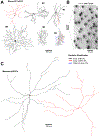Melanopsin and the Intrinsically Photosensitive Retinal Ganglion Cells: Biophysics to Behavior
- PMID: 31647894
- PMCID: PMC6944442
- DOI: 10.1016/j.neuron.2019.07.016
Melanopsin and the Intrinsically Photosensitive Retinal Ganglion Cells: Biophysics to Behavior
Abstract
The mammalian visual system encodes information over a remarkable breadth of spatiotemporal scales and light intensities. This performance originates with its complement of photoreceptors: the classic rods and cones, as well as the intrinsically photosensitive retinal ganglion cells (ipRGCs). IpRGCs capture light with a G-protein-coupled receptor called melanopsin, depolarize like photoreceptors of invertebrates such as Drosophila, discharge electrical spikes, and innervate dozens of brain areas to influence physiology, behavior, perception, and mood. Several visual responses rely on melanopsin to be sustained and maximal. Some require ipRGCs to occur at all. IpRGCs fulfill their roles using mechanisms that include an unusual conformation of the melanopsin protein, an extraordinarily slow phototransduction cascade, divisions of labor even among cells of a morphological type, and unorthodox configurations of circuitry. The study of ipRGCs has yielded insight into general topics that include photoreceptor evolution, cellular diversity, and the steps from biophysical mechanisms to behavior.
Keywords: circadian rhythms; intrinsically photosensitive retinal ganglion cell; melanopsin; membrane excitability; opsin; phototransduction; pupillary reflex; retina; signal transduction; sleep.
Copyright © 2019 Elsevier Inc. All rights reserved.
Conflict of interest statement
DECLARATION OF INTERESTS
The author is affiliated with the Center for Brain Science (Harvard University), the Division of Sleep Medicine (Brigham and Women’s Hospital, Harvard Medical School), and the Broad Institute of MIT and Harvard. He declares no competing interests.
Figures







References
Publication types
MeSH terms
Substances
Grants and funding
LinkOut - more resources
Full Text Sources
Molecular Biology Databases

